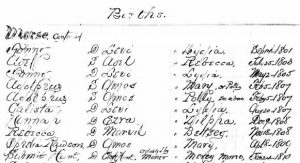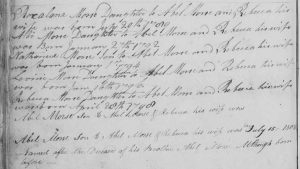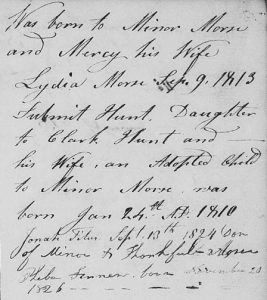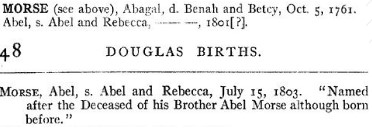In checking a source for an article in Mayflower Descendant, I was reminded of the need to check the various versions of early vital records. For many towns in Massachusetts, there are often three pre-1850 versions: 1) the published transcription (often called the “tan books”), 2) the Jay Mack Holbrook collection (on microfiche at NEHGS and digitized on Ancestry.com), and 3) the original vital records (often on microfilm and sometimes digitized on familysearch.org and/or Ancestry.com). Our handbook to New England genealogy is useful in determining which versions beyond the original records exist.
In this case, I was checking the reference to Abel Morse, born in Douglas, Massachusetts in 1803. I found a curious reference as well to an older sibling of the same name, as shown above. It would appear that Abel and Rebecca had a living son named Abel, and then had another son they had yet to name when their elder son Abel died, and so they named the newborn son after his now-deceased sibling. Still, I wanted to check what the original records said.

I ended up first looking at the Holbrook version of the Douglas records, which actually said less than this published version.
This version did not have the elder sibling Abel or the interesting notation found in the published version above. However, I was intrigued by the last notation, on “Submit Hunt,” daughter of “Clark Hunt, adopted by Miner [and] Mercy Morse, Jan. 24, 1810.” More on her later.
FamilySearch has most of the pre-1850 original Douglas records available online. They are not really that chronological or alphabetical, and it can take time to find the events you want, so having the published and Holbrook versions is an advantage. I found the original entry below.
 Essentially, I know the elder Abel has no recorded birthdate, so the “1801[?]” in the published version was likely a guess by the transcriber. All we know from this is that he probably died sometime after his younger brother’s birth on 15 July 1803.
Essentially, I know the elder Abel has no recorded birthdate, so the “1801[?]” in the published version was likely a guess by the transcriber. All we know from this is that he probably died sometime after his younger brother’s birth on 15 July 1803.
However, going back to the “Submit Hunt Morse” born on 24 January 1810 and “adopted by Miner”: I was intrigued by this entry, since I could not find this birth at all in the published version of records, only a birth for a Harriet Hunt, daughter of Clark and Zilpha, born in 1807. Just below is the original entry regarding Submit’s birth and adoption.
 Clark Hunt married Zilpha Alexander of Mendon, Massachusetts in 1806, and I also found two deaths in the Mendon Vital Records – a daughter Caroline, who died 1 February 1810, aged 1 year 4 months, and Zilpha herself, who died 24 June 1810, aged 35 years. Zilpha died just a few months after Submit’s birth (the father lived another twenty years), and so this youngest child was presumably adopted by another couple to give her a mother’s attention.
Clark Hunt married Zilpha Alexander of Mendon, Massachusetts in 1806, and I also found two deaths in the Mendon Vital Records – a daughter Caroline, who died 1 February 1810, aged 1 year 4 months, and Zilpha herself, who died 24 June 1810, aged 35 years. Zilpha died just a few months after Submit’s birth (the father lived another twenty years), and so this youngest child was presumably adopted by another couple to give her a mother’s attention.
“Submit H. Morse” died at Douglas 21 December 1829, which I found on Holbrook here, although the Ancestry transcription incorrectly lists the date and age for the person above. The digitized original version on familysearch.org does not cover deaths that late, so to check the original I would need to go the Douglas town clerk’s office. Still, it’s rather puzzling that neither this 1810 birth or 1829 death were in the published transcription. Did the transcriber purposely leave her out because of this adoption? That would seem unlikely given this transcription was in 1906 and this adopted child died unmarried.
So, when checking early Massachusetts Vital records and looking at the published, Holbrook, or original versions, it sometimes is a good idea to check all three!

As I understand it, this was a common practice back in that era. I point to Benedict Arnold as an example. Benedict Arnold (the infamous patriot/traitor) was actually Benedict Arnold V. When trying to sort out the lineage there was considerable confusion about where Benedict Arnold IV fell in the line. It turns out that he was Benedict Arnold IV was the eldest brother of Benedict Arnold V, who had died prior to the latter’s birth. Families supposedly did this to retain the memory of the earlier child.
I found a Lee child in Manchester vital records who didn’t seem to fit. There were no parents by the names given known in the area. When I later read the Holbrook fiches, I found that the printed version had his birth a full century off, and he fit neatly into a family with parents of the correct names.
For some towns, the Holbrook version is simply a photograph of the published vital records, but I thought that the Holbrooks tried to film the actual town records. If the Holbrook version looks like old handwriting, particularly if it looks like entries made at different times and not a handwritten transcription, how would we know which towns to visit to see the originals?
Thanks.
In older towns with older records there might be even more versions. For example, I’ve been looking at vital records of Andover in the mid 1600s. Family Search has images online of what appear to be the (1) Original Records: Massachusetts, Town Clerk, Vital and Town Records, 1626-2001 > Browse > Essex > Andover > Births, Marriages, Deaths 1651-1700.
Also, there is a 19th? C. (2) Handwritten Copy: Massachusetts, Town Clerk, Vital and Town Records, 1626-2001 > Browse > Essex > Andover > Births 1649-1801.
And then there is the (3) printed Vital Records of Andover to 1849 (tan books).
(4) In addition, in some counties early vital records were also filed with the county court. I found images of a handwritten copy of these on Family Search using the Genealogical Encyclopedia of the Colonial Americas by Christina K. Schaefer, p. 250 to find the film number. This gives the film number as 877432 [item 2]. (Use Search > Catalog > Film/Fiche Number.)
(5) Lastly, the Records and Files of the Quarterly Courts of Essex County have been published and also are available online here: http://salem.lib.virginia.edu/Essex/index.html (Find the person you seek using the online indexes for each volume.)
For reading the 1600s handwriting an article titled, “Colonial Handwriting” in Essex Antiquarian, vol, 1, pp. 175-6 was a great help.